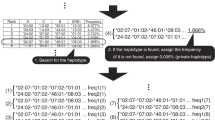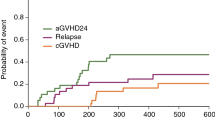Abstract
Allogeneic hematopoietic cell transplantation (HCT) offers the potential to cure hematologic malignancies. In the absence of an HLA-matched donor, HLA mismatched unrelated donors may be used, although risks of GvHD and treatment-related mortality (TRM) are higher. Identification and avoidance of amino-acid substitution and position types (AASPT) conferring higher risks of TRM and GvHD would potentially improve the success of transplantation from single HLA mismatched unrelated donors. Using random forest and logistic regression analyses, we identified 19 AASPT associated with greater risks for at least one adverse transplant outcome: grade III-IV acute GvHD, TRM, lower disease-free survival or worse overall survival relative to HLA-matched unrelated donors and to other AASPT. When tested in an independent validation cohort of 3530 patients, none of the AASPT from the training set were validated as high risk, however. Review of the literature shows that failure to validate original observations is the rule and not the exception in immunobiology and emphasizes the importance of independent validation before clinical application. Our current data do not support avoiding any specific class I AASPT for unrelated donors. Additional studies should be performed to fully understand the role of AASPT in HCT outcomes.
This is a preview of subscription content, access via your institution
Access options
Subscribe to this journal
Receive 12 print issues and online access
$259.00 per year
only $21.58 per issue
Buy this article
- Purchase on Springer Link
- Instant access to full article PDF
Prices may be subject to local taxes which are calculated during checkout


Similar content being viewed by others
References
Gragert L, Eapen M, Williams E, Freeman J, Spellman S, Baitty R et al. HLA match likelihoods for hematopoietic stem-cell grafts in the US registry. N Engl J Med 2014; 371: 339–348.
Flomenberg N, Baxter-Lowe LA, Confer D, Fernandez-Vina M, Filipovich A, Horowitz M et al. Impact of HLA class I and class II high-resolution matching on outcomes of unrelated donor bone marrow transplantation: HLA-C mismatching is associated with a strong adverse effect on transplantation outcome. Blood 2004; 104: 1923–1930.
Lee SJ, Klein J, Haagenson M, Baxter-Lowe LA, Confer DL, Eapen M et al. High-resolution donor-recipient HLA matching contributes to the success of unrelated donor marrow transplantation. Blood 2007; 110: 4576–4583.
Woolfrey A, Klein JP, Haagenson M, Spellman S, Petersdorf E, Oudshoorn M et al. HLA-C antigen mismatch is associated with worse outcome in unrelated donor peripheral blood stem cell transplantation. Biol Blood Marrow Transplant 2011; 17: 885–892.
Horan J, Wang T, Haagenson M, Spellman SR, Dehn J, Eapen M et al. Evaluation of HLA matching in unrelated hematopoietic stem cell transplantation for nonmalignant disorders. Blood 2012; 120: 2918–2924.
Liu H, Rich ES, Godley L, Odenike O, Joseph L, Marino S et al. Reduced-intensity conditioning with combined haploidentical and cord blood transplantation results in rapid engraftment, low GVHD, and durable remissions. Blood 2011; 118: 6438–6445.
Van Besien K, Liu H, Jain N, Stock W, Artz A . Umbilical cord blood transplantation supported by third-party donor cells: rationale, results, and applications. Biol Blood Marrow Transplant 2013; 19: 682–691.
Brunstein CG, Fuchs EJ, Carter SL, Karanes C, Costa LJ, Wu J et al. Alternative donor transplantation after reduced intensity conditioning: results of parallel phase 2 trials using partially HLA-mismatched related bone marrow or unrelated double umbilical cord blood grafts. Blood 2011; 118: 282–288.
Fleischhauer K, Kernan NA, O'Reilly RJ, Dupont B, Yang SY . Bone marrow-allograft rejection by T lymphocytes recognizing a single amino acid difference in HLA-B44. N Engl J Med 1990; 323: 1818–1822.
Keever CA, Leong N, Cunningham I, Copelan EA, Avalos BR, Klein J et al. HLA-B44-directed cytotoxic T cells associated with acute graft-versus-host disease following unrelated bone marrow transplantation. Bone Marrow Transplant 1994; 14: 137–145.
Ferrara GB, Bacigalupo A, Lamparelli T, Lanino E, Delfino L, Morabito A et al. Bone marrow transplantation from unrelated donors: the impact of mismatches with substitutions at position 116 of the human leukocyte antigen class I heavy chain. Blood 2001; 98: 3150–3155.
Kawase T, Morishima Y, Matsuo K, Kashiwase K, Inoko H, Saji H et al. High-risk HLA allele mismatch combinations responsible for severe acute graft-versus-host disease and implication for its molecular mechanism. Blood 2007; 110: 2235–2241.
Kawase T, Matsuo K, Kashiwase K, Inoko H, Saji H, Ogawa S et al. HLA mismatch combinations associated with decreased risk of relapse: implications for the molecular mechanism. Blood 2009; 113: 2851–2858.
Pidala J, Wang T, Haagenson M, Spellman SR, Askar M, Battiwalla M et al. Amino acid substitution at peptide-binding pockets of HLA class I molecules increases risk of severe acute GVHD and mortality. Blood 2013; 122: 3651–3658.
Marino SR, Lin S, Maiers M, Haagenson M, Spellman S, Klein JP et al. Identification by random forest method of HLA class I amino acid substitutions associated with lower survival at day 100 in unrelated donor hematopoietic cell transplantation. Bone Marrow Transplant 2012; 47: 217–226.
Breiman L . Random Forests. Machine Learning 2001; 45: 5–32.
Kaplan EL, Meier P . Nonparametric estimation from incomplete observations. J Am Stat Assoc 1958; 53: 457–481.
Cox DR . Regression models and life-tables. J R Stat Soc B 1972; 34: 187–220.
Gooley TA, Leisenring W, Crowley J, Storer BE . Estimation of failure probabilities in the presence of competing risks: new representations of old estimators. Stat Med 1999; 18: 695–706.
Zino E, Vago L, Di Terlizzi S, Mazzi B, Zito L, Sironi E et al. Frequency and targeted detection of HLA-DPB1 T cell epitope disparities relevant in unrelated hematopoietic stem cell transplantation. Biol Blood Marrow Transplant 2007; 13: 1031–1040.
Fleischhauer K, Shaw BE, Gooley T, Malkki M, Bardy P, Bignon JD et al. Effect of T-cell-epitope matching at HLA-DPB1 in recipients of unrelated-donor haemopoietic-cell transplantation: a retrospective study. Lancet Oncol 2012; 13: 366–374.
Pidala J, Lee SJ, Ahn KW, Spellman S, Wang HL, Aljurf M et al. Nonpermissive HLA-DPB1 mismatch increases mortality after myeloablative unrelated allogeneic hematopoietic cell transplantation. Blood 2014; 124: 2596–2606.
Oudshoorn M, Doxiadis II, van den Berg-Loonen PM, Voorter CE, Verduyn W, Claas FH . Functional versus structural matching: can the CTLp test be replaced by HLA allele typing? Hum Immunol 2002; 63: 176–184.
Fernandez-Vina MA, Wang T, Lee SJ, Haagenson M, Aljurf M, Askar M et al. Identification of a permissible HLA mismatch in hematopoietic stem cell transplantation. Blood 2014; 123: 1270–1278.
Wade JA, Hurley CK, Takemoto SK, Thompson J, Davies SM, Fuller TC et al. HLA mismatching within or outside of cross-reactive groups (CREGs) is associated with similar outcomes after unrelated hematopoietic stem cell transplantation. Blood 2007; 109: 4064–4070.
Duquesnoy R, Spellman S, Haagenson M, Wang T, Horowitz MM, Oudshoorn M . HLAMatchmaker-defined triplet matching is not associated with better survival rates of patients with class I HLA allele mismatched hematopoietic cell transplants from unrelated donors. Biol Blood Marrow Transplant 2008; 14: 1064–1071.
Baxter-Lowe LA, Maiers M, Spellman SR, Haagenson MD, Wang T, Fernandez-Vina M et al. HLA-A disparities illustrate challenges for ranking the impact of HLA mismatches on bone marrow transplant outcomes in the United States. Biol Blood Marrow Transplant 2009; 15: 971–981.
Spellman S, Klein J, Haagenson M, Askar M, Baxter-Lowe LA, He J et al. Scoring HLA class I mismatches by HistoCheck does not predict clinical outcome in unrelated hematopoietic stem cell transplantation. Biol Blood Marrow Transplant 2012; 18: 739–746.
Bjorkman PJ, Saper MA, Samraoui B, Bennett WS, Strominger JL, Wiley DC . The foreign antigen binding site and T cell recognition regions of class I histocompatibility antigens. Nature 1987; 329: 512–518.
Sugimoto K, Murata M, Terakura S, Naoe T . CTL clones isolated from an HLA-Cw-mismatched bone marrow transplant recipient with acute graft-versus-host disease. J Immunol 2009; 183: 5991–5998.
Elsner HA, Blasczyk R . Sequence similarity matching: proposal of a structure-based rating system for bone marrow transplantation. Eur J Immunogenet 2002; 29: 229–236.
Risler JL, Delorme MO, Delacroix H, Henaut A . Amino acid substitutions in structurally related proteins. A pattern recognition approach. Determination of a new and efficient scoring matrix. J Mol Biol 1988; 204: 1019–1029.
Kanda Y, Kanda J, Atsuta Y, Fuji S, Maeda Y, Ichinohe T et al. Changes in the clinical impact of high-risk human leukocyte antigen allele mismatch combinations on the outcome of unrelated bone marrow transplantation. Biol Blood Marrow Transplant 2014; 20: 526–535.
Kanda Y, Kanda J, Atsuta Y, Maeda Y, Ichinohe T, Ohashi K et al. Impact of a single human leucocyte antigen (HLA) allele mismatch on the outcome of unrelated bone marrow transplantation over two time periods. A retrospective analysis of 3003 patients from the HLA Working Group of the Japan Society for Blood and Marrow Transplantation. Br J Haematol 2013; 161: 566–577.
Binkowski TA, Marino SR, Joachimiak A . Predicting HLA class I non-permissive amino acid residues substitutions. PLoS ONE 2012; 7: e41710.
Fernandez-Vina MA, Klein JP, Haagenson M, Spellman SR, Anasetti C, Noreen H et al. Multiple mismatches at the low expression HLA loci DP, DQ, and DRB3/4/5 associate with adverse outcomes in hematopoietic stem cell transplantation. Blood 2013; 121: 4603–4610.
Acknowledgements
This study was partially supported by the University of Chicago Cancer Research Center, Chicago, Illinois (Fund-6-33573 to SRM). The CIBMTR is supported by Public Health Service Grant/Cooperative Agreement U24-CA076518 from the National Cancer Institute (NCI), the National Heart, Lung and Blood Institute (NHLBI) and the National Institute of Allergy and Infectious Diseases (NIAID); a Grant/Cooperative Agreement 5U10HL069294 from NHLBI and NCI; a contract HHSH250201200016C with Health Resources and Services Administration (HRSA/DHHS); two grants N00014-13-1-0039 and N00014-14-1-0028 from the Office of Naval Research; and grants from Actinium Pharmaceuticals; Allos Therapeutics, Inc.; Amgen, Inc.; Anonymous donation to the Medical College of Wisconsin; Ariad; Be the Match Foundation; Blue Cross and Blue Shield Association; Celgene Corporation; Chimerix, Inc.; Fred Hutchinson Cancer Research Center; Fresenius-Biotech North America, Inc.; Gamida Cell Teva Joint Venture Ltd.; Genentech, Inc.; Gentium SpA; Genzyme Corporation; GlaxoSmithKline; Health Research, Inc. Roswell Park Cancer Institute; HistoGenetics, Inc.; Incyte Corporation; Jeff Gordon Children’s Foundation; Kiadis Pharma; the Leukemia & Lymphoma Society; Medac GmbH; The Medical College of Wisconsin; Merck & Co, Inc.; Millennium: The Takeda Oncology Co.; Milliman USA, Inc.; Miltenyi Biotec, Inc.; National Marrow Donor Program; Onyx Pharmaceuticals; Optum Healthcare Solutions, Inc.; Osiris Therapeutics, Inc.; Otsuka America Pharmaceutical, Inc.; Perkin Elmer, Inc.; Remedy Informatics; Sanofi US; Seattle Genetics; Sigma-Tau Pharmaceuticals; Soligenix, Inc.; St. Baldrick’s Foundation; StemCyte, A Global Cord Blood Therapeutics Co.; Stemsoft Software, Inc.; Swedish Orphan Biovitrum; Tarix Pharmaceuticals; TerumoBCT; Teva Neuroscience, Inc.; THERAKOS, Inc.; University of Minnesota; University of Utah and Wellpoint, Inc. The views expressed in this article do not reflect the official policy or position of the National Institute of Health, the Department of the Navy, the Department of Defense, Health Resources and Services Administration or any other agency of the US Government.
Author information
Authors and Affiliations
Corresponding author
Ethics declarations
Competing interests
The authors declare no conflict of interest.
Additional information
Supplementary Information accompanies this paper on Bone Marrow Transplantation website
Supplementary information
Rights and permissions
About this article
Cite this article
Marino, S., Lee, S., Binkowski, T. et al. Identification of high-risk amino-acid substitutions in hematopoietic cell transplantation: a challenging task. Bone Marrow Transplant 51, 1342–1349 (2016). https://doi.org/10.1038/bmt.2016.142
Received:
Revised:
Accepted:
Published:
Issue Date:
DOI: https://doi.org/10.1038/bmt.2016.142



